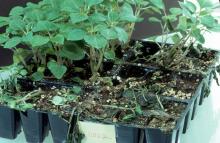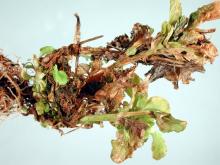See:
Greenhouse Plants, Ornamental - Pythium Seed Rot, Damping-off, and Root Rot
Cause Rhizoctonia spp. are soilborne fungi that survive as sclerotia or as mycelium colonizing bits of organic matter. Roots become infected as they grow past these structures. The fungus then grows along root surface and forms an aggregation called an infection cushion, then pushes into the root where it colonizes and kills the tissue. The fungus can form knots of mycelium that develop into sclerotia. These are released into the soil as the plant debris decomposes. Rhizoctonia can also grow across the soil/media surface to attack the base of stems or leaves in contact with the ground.
Damping-off can develop on the seed, radicle, hypocotyl, epicotyl, or stem of an emerged seedling. Cuttings may also be attacked by the fungus during rooting. It can enter cuttings through physical wounds or wounds from salt accumulation at the soil line. Other fungi such as Fusarium, Pythium and Phytophthora are also frequently involved with damping-off and cutting rots. It is not easy to tell these organisms apart by visual inspection so send to a Plant Clinic for diagnosis.
The fungus can be spread by water, contaminated tools, transportation of infected plants, and propagation of infected plants. Disease is favored by high temperatures, soil temperatures between 62°F and 79°F and moderately moist soils. Wounding, poor sanitation, and high nitrogen fertility can also favor disease development.
Many hosts are susceptible including alyssum, carnation, coleus, crocosmia, delphinium, Douglas-fir, ginseng, impatiens, lily, pansy, petunia, poinsettia, snapdragon, and tulip. Cold irrigation water greatly slows growth for a few hours following each watering and will prolong the maturation period and lengthen the time during which plants are susceptible to damping-off.
Symptoms Poor stand development or seedling collapse are indicative of damping-off. Seeds or emerging radicles may be rotted. After emergence, stem, root, and cotyledon may rot at or below the soil. A light brown mycelium may grow over the entire seedling and over large sections of trays. Cuttings will form a brown dry canker on the stem at the infection site. The canker enlarges up the stem and down into roots. Cuttings wilt and die.
Stem lesions, crown and root rot of older plants may also occur. Lesions are drier (compared to those by other organisms), reddish-brown to dark-brown and become slightly sunken. Lesions generally occur near the soil line. Stem and root lesions often are shallow but may extend deeper in young stem or root tissue. Sometimes brown mycelia or web-like growth may be visible with a hand lens on the surface of the lesions. Wilting, collapse, and death occur if lesions girdle the stem.
Densely planted seedlings or plants may develop a web blight where the fungus grows over and mats the leaves. It can also occur when leaves are in contact with the soil medium. In poinsettia, brown-cankered crown rots can occur without root rot. Longitudinal cracking and a dry appearance of the rotted crown tissue often develop on older plants.
Cultural control Good sanitation and cultural practices are essential including clean growing surfaces, clean water, and handling practices along with soilless media.
- Use culture-indexed plants free of the pathogen. Purchase new, clean seed.
- Use soilless potting mix or steam-treated soil and rooting media. Steam 30 min. at 180°F. Keep field soil out of contact with clean media.
- Avoid reusing pots or trays from a previous crop for propagation. If pots or trays must be reused then wash off all debris and soak in a sanitizing solution or treat with aerated steam for 30 min. Also disinfect any tools and equipment that might be used and contaminate the media.
- Maintain adequate fertility for moderate plant growth.
- Monitor soluble salt concentrations regularly. Use media pH and soil wetness appropriate for good crop growth.
- Water such that plants are not wet for extended periods of time.
- Remove plant debris during production and thoroughly clean and sterilize the greenhouse between production cycles.
- Control fungus gnats especially during rooting.
- Anaerobic soil disinfestation may be useful in some situations where a carbon source is incorporate into the soil or media, then irrigated to saturation, and then tarped to exclude oxygen. Use in combination with other techniques.
Chemical control Cultural controls reduce or eliminate the need for chemical drenches. Chemical treatment should be preceded by an accurate diagnosis since most of the chemicals are not effective against all the pathogens that might cause damping-off. If used, treatments must be made before infection occurs. Rotate among fungicides from different groups with different modes of action. Be sure to check labels for crop safety before application. Drench only the upper 25% of the potting media or use a sprench when managing stem and crown rots.
- Affirm WDG at 0.25 to 0.5 lb/100 gal water applied as a soil drench. Group 19 fungicide. 4-hr reentry.
- Banrot 40 WP at 6 to 12 oz/100 gal water. Avoid using the granular formulation. Group 1 + 14 fungicide. 12-hr reentry.
- Broadform at 2 to 8 fl oz/100 gal water. Group 7 + 11 fungicide. 12-hr reentry.
- Chipco 26019 FLO at 13 fl oz/100 gal water. Use 1 to 2 pints of this solution per sq ft. Group 2 fungicide. 12-hr reentry.
- Empress at 1 to 3 fl oz/100 gal water can be used for cuttings or seedlings. Group 11 fungicide. 12-hr reentry.
- Fame at 0.2 to 0.6 fl oz/100 gal water as a soil drench. Group 11 fungicide. 12-hr reentry.
- Heritage at 1 to 4 oz/100 gal water plus an adjuvant. Group 11 fungicide. 4-hr reentry.
- Medallion WDG at 1 to 2 oz/100 gal water. Using with oils or adjuvants may damage plant. Group 12 fungicide. 12-hr reentry.
- Pageant at 12 to 18 oz/100 gal water used as drench. Do not use with organosilicone-based adjuvants. Group 7 + 11 fungicide. 12-hr reentry.
- Palladium at 4 to 6 oz/100 gal water. Avoid excessive runoff to small plants, which may result in stunting and/or chlorosis. Group 9 + 12 fungicide. 12-hr reentry.
- ProStar 70 WG at 3 to 12 oz/100 gal water. Group 7 fungicide. 12-hr reentry.
- Spirato GHN at 1 to 2 fl oz/100 gal water. Use with oils or adjuvants may cause plant damage. Group 12 fungicide. 12-hr reentry.
- Terraclor 400 at 6 to 12 fl oz/100 gal water plus an adjuvant. Application rate of this solution is based on pot diameter and/or depth of soil, see label for details. Excellent efficacy. Group 14 fungicide. 12-hr reentry.
- Terraguard SC at 4 to 8 fl oz/100 gal water. Group 3 fungicide. 12-hr reentry.
- Thiophanate-methyl-based products. Inconsistent efficacy. Group 1 fungicides. 12-hr reentry.
- Cleary's 3336 EG at 8 to 16 oz/100 gal water.
- OHP 6672 4.5 F at 7.5 to 20 fl oz/100 gal water.
Biological control Use in conjunction with other control tactics such as thorough sanitation.
- Actinovate SP (Streptomyces lydicus strain WYEC 108) at 6 oz/100 gal water as a soil drench. Do not mix with Regalia or certain copper or sulfur based products. 4-hr reentry. O
- Asperello T34 (Trichoderma asperellum strain T34) at 0.35 oz/35 sq ft of substrate before potting. Do not mix or use with other fungicides for 10 days. See label for details. 12-hr reentry. O
- Bexfond (Bacillus amyloliquefaciens subspecies plantarum strain FZB42) at 0.5 fl oz/10 gal water is registered as a drench. Use 3 to 9.5 fl oz/sq ft. Unknown efficacy in the PNW. Group BM02 fungicide. 4-hr reentry. O
- Bio-Tam 2.0 or Tenet WP or Obtego (Trichoderma asperellum and T. gamsii) at 0.5 to 1.5 lb/cubic yard of substrate. See label for details. No restrictions on reentry when soil incorporated. O
- LALStop G46 WG (Clonostachys rosea [formerly Gliocladium catenulatum] strain J1446) at 0.33 oz/5 gal water. Do not use with other products in the tank.4-hr reentry. O
- LALStop K61 WP (Streptomyces Strain K61) at 0.07 oz/100 to 200 sq ft. Apply with enough water to move product into the root zone. Can be used as a soil spray, drench, dip or incorporated into potting media. 4-hr reentry. O
- Mycostop (Streptomyces Strain K61) at 1 to 2 grams/100 sq ft. Apply with enough water to move product into the root zone. Can be used as a soil spray, drench, dip or incorporated into potting media. 4-hr reentry. O
- PlantShield HC (Trichoderma harzianum Rifai strain T-22) at 3 to 5 oz/100 gal water as a soil drench. 4-hr reentry. O
- Pro-Mix BX (Bacillus pumilus strain GHA180) is sphagnum peat moss, perlite, vermiculite, dolomitic limestone and calcitic limestone with the bacteria already incorporated into the mix. The mycorrhizae fungus Glomus intraradices is also incorporated for enhanced nutrient uptake. 0-hour reentry.
- RootShield Plus Granules (Trichoderma harzianum Rifai strain T-22 and T. virens strain G-41) at 1 to 3 lb/cubic yard soil mix. No restrictions on reentry required when soil incorporated. O
- SoilGard (Gliocladium virens strain GL-21) at 2 to 4 oz/100 gal water. Unknown efficacy in the PNW. Group BM02 fungicide. 4-hr reentry. O
- Stargus (Bacillus amyloliquefaciens strain F727) at 2 to 4 quarts/100 gal water plus a nonionic surfactant as a soil drench. Weekly applications were effective in one Viburnum trial. Group BM02 fungicide. 4-hr reentry. O
- Subtilex NG (Bacillus subtilis stain MBI 600) at 0.2 to 0.4 oz/100 gal is registered as a drench. Unknown efficacy in the PNW. Group BM02 fungicide. 4-hr reentry. O
- Triathlon BA (Bacillus amyloliquefaciens strain D747) at 0.5 to 6 quarts/100 gal water.Group BM02 fungicide. 4-hr reentry. O
- Zio (Pseudomonas chlororaphis strain AFS009) at 6.7 to 10 oz/10 gal water as a soil drench. Unknown efficacy in the PNW. 4-hr reentry. O
References Benson, D.M. 1991. Control of Rhizoctonia stem rot of Poinsettia during propagation with fungicides that prevent colonization of rooting cubes by Rhizoctonia solani. Plant Disease 75:394-398.
Chase, A. R. and Zemke, M. 2024. Q and A for Disease Control. Chase Digest 12 (2):7
Gutierrez Yanez, D., Testen, A. L. and Peduto Hand, F. 2024. Evaluation of anaerobic soil disinfestation to reduce soilborne diseases in soilless and soil-based substrates for specialty cut flower production. Plant Disease, 108:908-919.
Wolcan, S.M., Malbran, I., Mourelos, C.A., Sisterna, M.N., Gonzalez, M.P., Alippi, A.M., Nico, A., and Lori, G.A. 2018. Diseases of Carnation. In McGovern, R.J. and Elmer, W.H. (eds.) Handbook of Florists' Crops Diseases. Springer Int.
Wegulo, S.N., and Chase, A.R. 2018. Diseases of Snapdragon. In McGovern, R.J. and Elmer, W.H. (eds.) Handbook of Florists' Crops Diseases. Springer Int.



